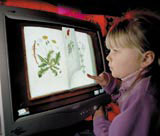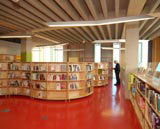Back to books

With library usage in decline, these often-neglected interiors need updating, to bring them into the 21st century and regain public interest. Pamela Buxton explains how designers are looking to retail environments for inspiration
When Brighton & Hove Council opened the £14m Jubilee Library, visitor numbers shot up threefold. It was a similar story at the Idea Store in London’s Whitechapel and the Gosport Discovery Centre in Hampshire – all of which were flagship projects, offering new concepts in library design.
These are encouraging signs that good, adequately-funded design can help boost library use at a time when library book lending is in steady decline – a trend only likely to increase, with the prospect of entire books becoming available on the Internet or downloadable as hand-held ‘electronic books’.
‘I think design is a key marketing tool for the library and one that is often overlooked,’ says Angela Dove, a knowledge space consultant who recently ran a series of design workshops for the Chartered Institute of Library and Information Professionals. ‘Libraries mustn’t go for some sort of corporate image, but ought to reflect the locality,’ she says, adding that this should mean high quality, contemporary design, rather than a lowest-common-denominator municipal approach.
Certainly it is food for thought for library service providers and their designers, who are having to readdress the nature, form and sometimes even the name of the conventional library to meet 21st century needs. For this, designers are looking outside the library sector, to the world of retail in particular, for tactics to draw people into libraries and, once they are inside, to put them at ease and enable them to find what they want.
‘The idea is to remove the reservations people may have about going into an educational building, and recreate an environment they are used to – something, perhaps, closer to a retail environment than a traditional [educational] building,’ says Martin Kaefer of Adjaye Associates, project director for the Whitechapel branch of the Idea Store concept, which is at the forefront of a trend to combine libraries with other services, encompassing adult education, crêche and café facilities. Branding for the concept is by Bissett Adams.
‘Like a bookshop, you have to show what’s on display to draw people in,’ adds Wayne Glaze, senior associate of Hawkins Brown, which is designing a new library at Boscombe near Bournemouth, due for completion early next year.
The retail approach is applied inside and out – the library interior will be well lit and easily navigable, without relying solely on signs, helped by views of the different library areas that can be glimpsed from the long entrance ramp. But, like any good shop, the design shouldn’t overwhelm the merchandise. ‘We’re not plastering it in a lot of condescending primary colours – the colour is introduced by the books themselves,’says Glaze.
In the new breed of libraries, staff will no longer stand behind intimidating counters. Instead, self-issue systems will be introduced, meaning that more librarians can be on the library floor. There will also be a variety of both quiet and lively environments, and a more contemporary atmosphere.

This is particularly evident at the Whitechapel Idea Store. ‘It is lively and there are noises,’ says Kaefer. ‘But there are spaces, like the classrooms on all floors, which you can use to read in. You don’t want to create an environment that’s patronising, but one that is easy to adapt to and use.’
With maintenance a priority, the interior has a robust, industrial aesthetic, through the use of metal laminate wall coverings, red rubber flooring and an exposed concrete ceiling. Adjaye worked with design consultancy Mode on the graphics – essential to help create an easy-to-navigate interior.
‘The whole idea was to empower people to discuss things for themselves, rather than approach staff and ask,’ says Mode director Ian Styles. Inspired by the architecture, Mode used 3D signs, resembling book spines, emerging from the wall, and provided suitably tough signs using colour-coded, anodised aluminium.
But what’s right for London’s East End is not necessary appropriate elsewhere. At Brighton’s Jubilee Library, winner of the 2005 Better Public Building award, Bennetts Associates created a calmer, more book-focused environment. ‘I think the reaction has confirmed our gut feeling that people still, mainly, come for books,’ says director Rab Bennetts. The main reference library is supplemented with a variety of spaces for other functions – including a children’s library and a music area, where users can play music out loud. Aesthetically, he says, it is a calm, but tactile, warm space, with plenty of timber panelling around the main space to help temper noise, painted concrete and a bright carpet.
Refurbishments can have as dramatic an impact on library use as smart new buildings, as shown at Gosport Discovery Centre, which combines library and display facilities. It more than doubled its library footfall after investing £2million in a refurbishment by Hampshire County Council Architects. Completed last year, this redesign replaced drab browns and greys with bright colours, new furniture, better lighting, an appealing children’s area and an artist-designed stained glass entrance lobby.
With the books-versus-computers debate long over, contemporary technology is a must. On one level, this could mean plasma screens at the Ideas Stores, which suit the busy, vibrant atmosphere. On another level, it could be the touch-screen kiosks at the British Library – designed with Armadillo Systems – which allow visitors to turn the pages of precious manuscripts on-screen, with the originals viewed safely under glass.
But many commissioners of libraries are first-time clients, a problem tackled by a new Museums, Libraries and Archives Council-funded website (www.designinglibraries.org.uk), which aims to disseminate best practice in library design.
‘People involved in library design projects are, in the vast majority of cases, coming to the process unprepared,’ says Designing Libraries coordinator Alan Clark, who wants greater dialogue between library and design sectors. ‘We are making attempts to contact and talk to architects and designers, to find out what they need to know. The feedback we’re getting is very positive,’ he says.
And, with predictions from book campaigners Libris that, unless they radically change soon, libraries will be extinct in 20 years, the library sector needs all the help it can get to reinvent itself into a form that appeals to contemporary, rather than outmoded Victorian, aspirations.
Book ends: Library facts and statistics
• UK library users have dropped by 21 per cent since 1995 and book-borrowing by 31 per cent, according to a House of Commons Select Committee’s report on Public Libraries published last year. The report said ‘a significant barrier to library use was shabby buildings’.
• According to the Department for Culture, Media and Sport, 60 per cent of people in this country have a library ticket. There are 3600 static and 460 mobile libraries in England. In 2003/4, 285 million visits were paid to libraries and 324 million items were lent.
• More books will soon be available on-line, as both Microsoft and Google plan digital library services. Microsoft is working with the Open Content Alliance to put 150 000 works on-line and plans a prototype library search service this year. Google plans to digitise works from Harvard, Stanford and Michigan universities to make them searchable.
• Meanwhile, electronic books are on their way. Sony, Philips and digital paper pioneer E-Ink have launched an electronic book-reader called Librié. The device, currently available only in Japan, is the size of a paperback and can hold 500 downloaded texts.
-
Post a comment



